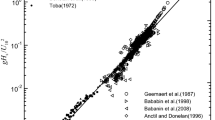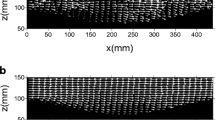Abstract
The role of the surface roughness in the formation of the aerodynamic friction of the water surface at high wind speeds is investigated. The study is based on a wind-over-waves coupling theory. In this theory waves provide the surface friction velocity through the form drag, while the energy input from the wind to waves depends on the friction velocity and the wind speed. The wind-over-waves coupling model is extended to high wind speeds taking into account the effect of sheltering of the short wind waves by the air-flow separation from breaking crests of longer waves. It is suggested that the momentum and energy flux from the wind to short waves locally vanishes if they are trapped into the separation bubble of breaking longer waves. At short fetches, typical for laboratory conditions, and strong winds the steep dominant wind waves break frequently and provide the major part of the total form drag through the air-flow separation from breaking crests, and the effect of short waves on the sea drag is suppressed. In this case the dependence of the drag coefficient on the wind speed is much weaker than would be expected from the standard parameterization of the roughness parameter through the Charnock relation. At long fetches, typical for the field, waves in the spectral peak break rarely and their contribution to the air-flow separation is weak. In this case the surface form drag is determined predominantly by the air-flow separation from breaking of the equilibrium range waves. As found at high wind speeds up to 60 m s−1 the modelled aerodynamic roughness is consistent with the Charnock relation, i.e. there is no saturation of the sea drag. Unlike the aerodynamic roughness, the geometrical surface roughness (height of short waves) could be saturated or even suppressed when the wind speed exceeds 30 m s−1.
Similar content being viewed by others
References
Babanin AV, Young IR (2005) Two-phase behaviour of the spectral dissipation of wind waves. In: Proceedings ocean waves measurement and analysis, fifth int sym WAVES 2005, 3–7 July, 2005, Madrid, Spain, Edge B, Santas JC, (eds) paper no. 51, 11
Banner ML (1990). The influence of wave breaking on the surface pressure distribution in wind wave interaction. J Fluid Mech 211: 463–495
Banner ML and Melville WK (1976). On the separation of air flow above water waves. J Fluid Mech 77: 825–842
Bye JAT, Jenkins AD (2006) Drag coefficient reduction at very high wind speeds. J Geophys Res 111, C033024, doi:10.1029/2005JC003114
Donelan MA, Hamilton J and Hui WH (1985). Directional spectra of wind generated waves. Phil Trans R Soc Lond, Ser A 315: 509–562
Donelan MA, Haus BK, Reul N, Plant WJ, Stiassnie M, Graber HC, Brown OB, Saltzman ES (2004) On the limiting aerodynamic roughness of the ocean in very strong winds. Geophys Res Lett 31, L18306, doi:10.1029/2004GL019460
Donnelly WJ, Carswell JR, McIntosh RE, Chang PS, Wilkerson J, Marks F and Black PG (1999). Revised ocean backscatter models at C and Ku band under high-wind conditions. J Geophys Res 104: 11485–11497
Emanuel KA (1995). Sensitivity of tropical cyclones to surface exchange coefficients and a revised steady-state model incorporating eye dynamics. J Atmos Sci 52: 3969–3976
Giovanangeli JP, Reul N, Garat MH, Branger H (1999) Some aspects of wind-wave coupling at high winds:an experimental study. In: Wind-over-wave couplings. pp 81–90, Clarendon Press, Oxford 356 pp
Hersbach H (2003) CMOD5 an improved geophysical model function for ERS C-band scatterometry,/ Techn. Mem./, ECMWF, Reading, UK
Kawamura H and Toba Y (1988). Ordered motions in the turbulent boundary layer over wind waves. J Fluid Mech 197: 105–138
Komen GJ, Cavalery L, Donelan M, Hasselmann K, Hasselmann S, Janssen PAEM (1994) Dynamics and modelling of ocean waves. Cambridge University Press, 540 pp
Kudryavtsev VN (2006) On effect of sea drops on atmospheric boundary layer. J Geophys Res 111: C07020, doi:10.1029/2005JC002970
Kudryavtsev VN and Makin VK (2001). The impact of air-flow separation on the drag of the sea surface. Boundary-Layer Meteorol 98: 155–171
Kudryavtsev VN, Makin VK and Chapron B (1999). Coupled sea surface-atmosphere model 2. Spectrum of short wind waves. J Geophys Res 104: 7625–7639
Kudryavtsev V, Hauser D, Caudal G, Chapron B (2003) A semi-empirical model of the normalized radar cross-section of the sea surface. Part 1: The background model. J Geophys Res 108(C3):8054, doi:10.1029/2001JC001003
Lonquet-Higgins MS (1957). The statistical analysis of a random moving surface. Phil Trans R Soc Lond, Ser A 249: 321–387
Makin VK (2005). A note on drag of the sea surface at hurricane winds. Boundary-Layer Meteorol 115: 169–176
Makin VK and Kudryavtsev VN (1999). Coupled sea surface- atmosphere model 1. Wind over waves coupling. J Geophys Res 104: 7613–7623
Makin VK and Kudryavtsev VN (2002). Impact of dominant waves on sea drag. Boundary-Layer Meteorol 103: 83–99
Makin VK, Caulliez G, Kudryavtsev VN (2004) Drag of the water surface at limited fetch: laboratory measurements and modelling. In: Geophysical research abstracts 1016, EGU04-A-00113, EGU General Assembly, April 25–31, 2004, Nice, France
Melville WK (1996). The role of surface-wave breaking in air-sea interaction. Ann Rev Fluid Mech 28: 279–321
Monin AS, Yaglom AM (1971) Statistical fluid mechanics, vol 1. Cambridge: MIT Press 769 pp
Reul N, Branger H and Giovanangeli JP (1999). Air flow separation over unsteady breaking waves. Physics of Fluids 11: 1959–1961
Phillips OM (1985). Spectral and statistical properties of the equilibrium range in wind generated gravity waves. J Fluid Mech 156: 505–531
Powell MD, Vickery PJ and Reinhold TA (2003). Reduced drag coefficient for high wind speeds in tropical cyclones. Nature 422: 279–283
Author information
Authors and Affiliations
Corresponding author
Rights and permissions
About this article
Cite this article
Kudryavtsev, V.N., Makin, V.K. Aerodynamic roughness of the sea surface at high winds. Boundary-Layer Meteorol 125, 289–303 (2007). https://doi.org/10.1007/s10546-007-9184-7
Received:
Accepted:
Published:
Issue Date:
DOI: https://doi.org/10.1007/s10546-007-9184-7




